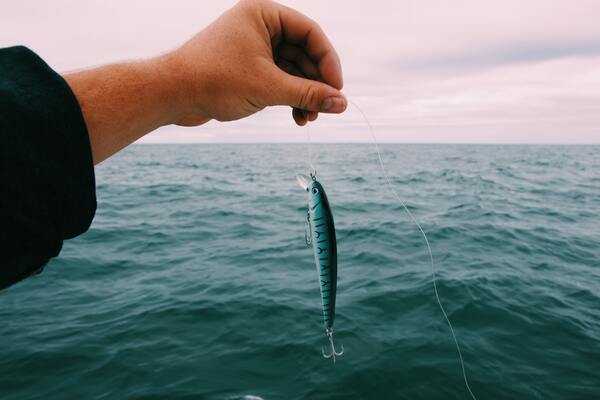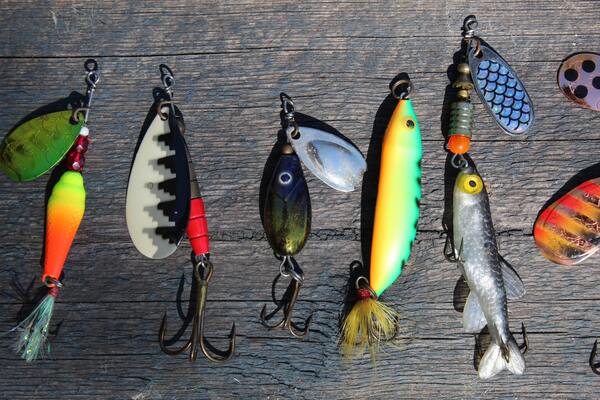Chatterbaits are alluring jigs that can be attached to the fishing hook on the rod and typically come in a variety of patterns that resemble weeds or worms. Do you want to discover a brand-new, simple technique for attaching these baits so you can resume fishing right away?
A Chatterbait
A chatterbait is a specific kind of fishing lure or jig. In particular, it’s a particular kind of lure or jig with a variety of features that’s primarily used for bass fishing. It has a distinctive shape. The term “Chatterbait” today can refer to both the original bait that first went by that name as well as other baits with a similar look, feel and purpose.
Because the hook always remains in the upright position, the Chatterbait has the benefit of being completely “weedless” (won’t get tangled in weeds). Anglers can now throw the bait into dense cover, where it is known that fish can live and feed.
The Chatterbait is a very adaptable jig that can be used in both shallow and deep water and a variety of ways. Some anglers might decide to take the skirt and trailer off the Chatterbait and use a soft plastic jerk bait on the end in their place.
Fish schools have been known to respond well to this combination. You can also try adding a spider jig or creature bait when fish are holding close to the lake or pond bottom. This will enable you to hop, bounce, or swim the bait around deep cover for a vibrating, deep water assault.
How To Tie A Chatterbait
Grab Some Fishing Line
To tie on your Chatterbait, you will need to have some sort of fishing line available. Here, you are free to use any type of line—braided or monofilament—and any test you like; just be sure to match the line you’re using to the appropriate fishing conditions you’re likely to encounter.
Pass The Line Through
Pass the line through the Chatterbait’s eyelet while holding it by the hexagonal blade. If you want to later suspend the lure from the fishing area’s bottom, make sure you pull enough line across the hole.
If you plan to fish in shallow water only, just 1-2 feet of the line should be sufficient. If you plan to fish in open water, you should secure about 4-5 feet of line. We will later form a loop, so leave a few inches in the line.
Form a Loop
Making a loop, feed the fishing line’s end back through the Chatterbait’s eye. The next step is to tie an “overhand knot” by taking the end of the line that has been looped and wrapping the free end twice—once around the standing portion and once through it.
Pass-Through The Hoop
To ensure there is enough room in the loop, gently pull the line through the eyelet. Pass the Chatterbait back through the loop at this point to ensure a tight tie.

Secure The Knot
The loop should now be positioned below the Chatterbait’s hole in this final step of the procedure. Use saliva or water to moisten the line before connecting to ensure a strong connection. This will also help to avoid tangles and stiff lines.
Cut the line from the spool using fingernail clippers or needle nose pliers after gently but firmly pulling both ends of the line—the line that is doubled through the Chatterbait and the line on the spool—together to secure the knot.
When Should You Use A Chatterbait
The fact that a chatterbait can go where spinnerbaits cannot is one of the primary reasons why people use them. For instance, thick weeds and grass are no match for a chatterbait.
With an exposed hook, it will float right over the top and continue to wiggle. They may or may not breach the surface of the water as a result of explosive strikes.
When you see grass nearby, you should tie on a chatterbait, drop it in the middle of it, and get it moving quickly! The thing that will jump out to get it might surprise you. If you want to cover a large area in your search for fish, a spinnerbait or crankbait would be a good choice to work the edge of the grass or weedline.
Tips For Your Chatterbait
The chatter bait vibrates and moves quite a bit. A plastic trailer attached to the bladed jig, on the other hand, will add more buoyancy, bulk, and action to attract bass. Additionally, by picking a contrasting color, you can give your plastic trailer more color.
Your chatter bait success will be greatly impacted by the blade colors you select. Anglers who have fished in contaminated water may want to use gold in clear and sunny conditions, chrome in clear and sunny conditions, or green or black to imitate crawfish.
If you use a rod that is too stiff, your hookup ratio will suffer. The fish will catch the bait more easily if you use a softer rod.
The trailers control how far below the surface of the water your lure swims. When fishing close to submerged grass or docks, you want to keep the bait elevated in the water column. Use a bulkier or boot-tail plastic to hold it high up. Alternative options include choosing a less durable, thinner plastic.
Faster reeling is ineffective when using chatter baits. It’s because it will mess up how the lure acts. The chatter bait takes care of everything and behaves erratically. To make the bait work, you don’t need to reel it in quickly. It is expected that a slow reeler will catch more fish.
Conclusion
Many of the other baits in your tackle box won’t always perform as well as a Chatterbait. The best times to use chatter baits seem to be early spring and late fall. Even in colder water temperatures, the chatter bait occasionally attracts reaction strikes thanks to its quick shaking.
The skirt shifting in the water or the blade’s vibration can provide the extra movement that bass sometimes craves. A poor fishing day can be improved with just a little bit of extra effort.

